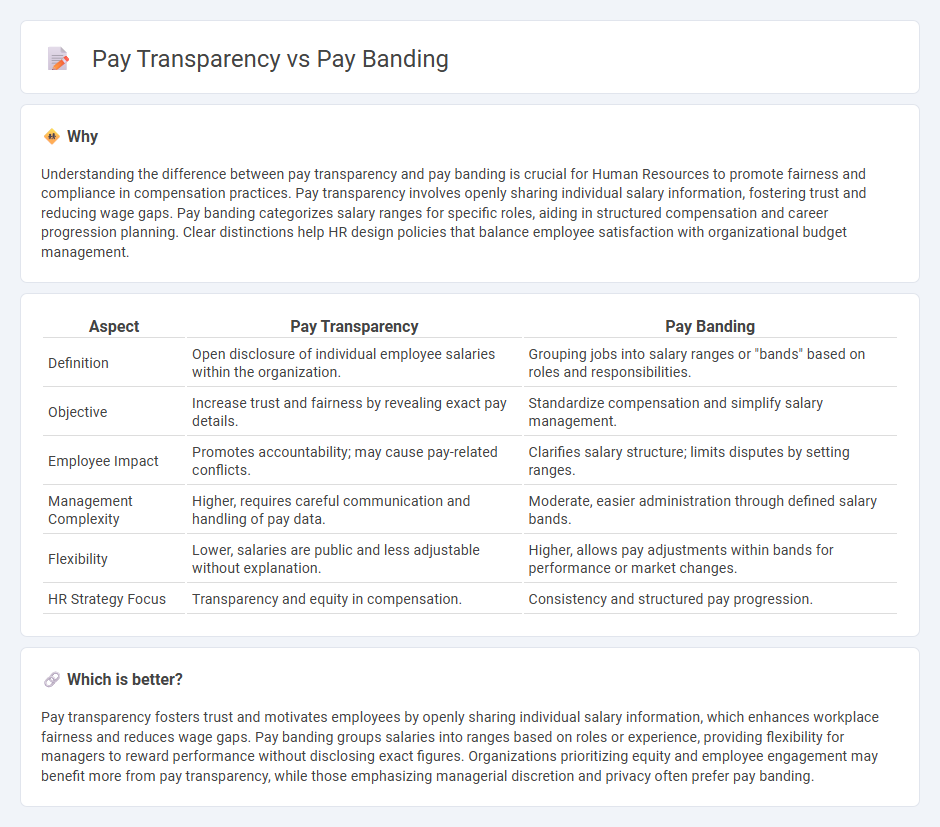
Pay transparency enhances employee trust by openly sharing salary information, while pay banding organizes compensation into defined salary ranges to maintain internal equity and manage expectations. Both strategies aim to reduce pay disparities and improve organizational fairness through clear compensation structures. Explore how integrating pay transparency with pay banding can optimize workforce motivation and retention.
Why it is important
Understanding the difference between pay transparency and pay banding is crucial for Human Resources to promote fairness and compliance in compensation practices. Pay transparency involves openly sharing individual salary information, fostering trust and reducing wage gaps. Pay banding categorizes salary ranges for specific roles, aiding in structured compensation and career progression planning. Clear distinctions help HR design policies that balance employee satisfaction with organizational budget management.
Comparison Table
| Aspect | Pay Transparency | Pay Banding |
|---|---|---|
| Definition | Open disclosure of individual employee salaries within the organization. | Grouping jobs into salary ranges or "bands" based on roles and responsibilities. |
| Objective | Increase trust and fairness by revealing exact pay details. | Standardize compensation and simplify salary management. |
| Employee Impact | Promotes accountability; may cause pay-related conflicts. | Clarifies salary structure; limits disputes by setting ranges. |
| Management Complexity | Higher, requires careful communication and handling of pay data. | Moderate, easier administration through defined salary bands. |
| Flexibility | Lower, salaries are public and less adjustable without explanation. | Higher, allows pay adjustments within bands for performance or market changes. |
| HR Strategy Focus | Transparency and equity in compensation. | Consistency and structured pay progression. |
Which is better?
Pay transparency fosters trust and motivates employees by openly sharing individual salary information, which enhances workplace fairness and reduces wage gaps. Pay banding groups salaries into ranges based on roles or experience, providing flexibility for managers to reward performance without disclosing exact figures. Organizations prioritizing equity and employee engagement may benefit more from pay transparency, while those emphasizing managerial discretion and privacy often prefer pay banding.
Connection
Pay transparency fosters trust and accountability by openly sharing salary information within an organization, directly linking to pay banding, which establishes defined salary ranges for specific roles. Pay banding structures provide clear guidelines that support transparent communication about compensation, reducing wage disparities and promoting equity. Together, pay transparency and pay banding enhance employee satisfaction and retention by ensuring fairness and clarity in compensation practices.
Key Terms
Salary Range
Pay banding groups salary ranges into broad categories to simplify compensation management, while pay transparency involves openly sharing precise salary ranges within an organization. Salary range clarity through pay transparency can enhance employee trust and reduce wage disparities, whereas pay banding provides flexible salary structures aligned with job levels. Discover how these approaches impact organizational culture and compensation strategy in detail.
Compensation Disclosure
Pay banding groups jobs with similar pay ranges to promote internal equity and simplify compensation management, while pay transparency involves openly sharing salary information to build trust and improve employee motivation. Compensation disclosure policies vary widely, with some organizations embracing full transparency and others limiting details to maintain privacy and competitive advantage. Explore more to understand how pay banding and pay transparency impact employee satisfaction and organizational culture.
Equity
Pay banding groups jobs into defined salary ranges to promote internal equity by reducing pay disparities across similar roles. Pay transparency involves openly sharing salary information to ensure fairness and build trust, fostering external and internal equity perceptions. Explore how integrating pay banding with transparency strategies can enhance equitable compensation practices.
Source and External Links
What is a Salary Band? A Guide for HR Professionals - Indeed - Salary bands are pay ranges set by organizations grouping jobs with similar requirements into ranges that facilitate pay management and reflect role value based on market and internal factors.
What is a Salary Band? | HR & Payroll Glossary - Paylocity - A salary band is a framework defining the minimum and maximum pay for job categories, helping employers promote pay equity, manage budgets, and attract talent by grouping similar roles into pay ranges.
How to create a best practice salary band structure: effective, fair ... - Salary bands structure compensation by setting pay ranges with a typical spread around a midpoint, allowing measurement of employee progression within bands via metrics like salary range penetration and compa ratio.
 dowidth.com
dowidth.com